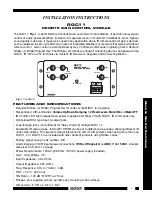
D8125 | Installation and Operation Guide | 5.0 Troubleshooting
.
Bosch Security Systems B.V. | 2020.04 | F01U036298-15
33
5.1.2 Problems with Points
If you incorrectly set the switches on a POPIT you may create both a missing and extra point. When you find a
missing point, perform a Service Walk Test to search for extra points.
System
Diagnosis
Remedy
Point appears as missing
at key pads and in reports
to the receiver.
POPIT is not connected or
incorrectly connected to
the data expansion loop.
Verify that a POPIT module programmed for the
missing point number is connected to the data
expansion loop of the correct ZONEX module.
Points 9 to 127 connect to ZONEX module 1. Points
129 to 247 connect to ZONEX module 2.
Meter each POPIT to verify the polarity of the data
expansion loop. Voltage should be 9 to 13 VDC at
each POPIT.
D8128C OctoPOPIT is
installed at the last address
on the ZONEX bus.
Install a D8125 POPEX and D9127 POPITs for
Points 121-127 on ZONEX 1 and for Points 241-247
on ZONEX 2.
Sensor loop switch (1 to 8)
is turned off on OctoPOPIT.
If the sensor loop switch on an OctoPOPIT is turned
off for a programmed point, the point reports as
missing.
POPIT is not programmed
correctly.
Verify that the switches on the POPIT are set for the
missing POPIT number. Switches set incorrectly can
cause both missing and extra POPITs.
Performing a Service Walk Test to search for extra
points may help diagnose the problem.
Points intermittently
appear as missing. Points
are erratic.
Problem with data
expansion loop.
See
Section 15.7
Problems with D8125 POPEX Data
Expansion Loops
in the
D9412G/D7412G Operation
and Installation Guide
(P/N:
43448).
Debounce Count parameter
set at 1. If an off-board
point is in transition
between normal and
faulted conditions as the
control panel scans it, it
appears as missing.
It is recommended that the Debounce Count be left
at the default of 2, with the exception of Interior
Follower Points, where the Debounce Count should
be set to 3.
Decreasing the Debounce Count to 1 may cause
points to appear as missing. Increasing the
Debounce may cause missed alarms.
One or more points
remain in trouble or
alarm with all devices
connected to the sensor
loops normal.
The sensor loop is open,
shorted, or grounded.
Opens, shorts, or grounds
cause troubles or alarms
depending on point
programming.
Remove the sensor loop from the D9412/D9112 or
POPIT and meter it for continuity. There should be
no more than 100
⋅
resistance, plus the value of the
end of line resistor on the wires. If you meter less
resistance than the value of the end of line resistor,
check the wiring for shorts.
With the wires for the loop removed, meter them for
continuity to ground. A ground before the end of
line resistor on an on-board point’s sensor loop is
interpreted as a short. A ground on a sensor loop
for a POPIT point is interpreted as an open.








































